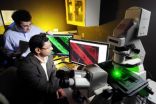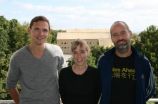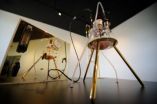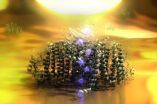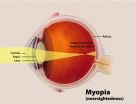(Press-News.org) Modulating immune response to injury could accelerate the regeneration of severed peripheral nerves, a new study in an animal model has found. By altering activity of the macrophage cells that respond to injuries, researchers dramatically increased the rate at which nerve processes regrew.
Influencing the macrophages immediately after injury may affect the whole cascade of biochemical events that occurs after nerve damage, potentially eliminating the need to directly stimulate the growth of axons using nerve growth factors. If the results of this first-ever study can be applied to humans, they could one day lead to a new strategy for treating peripheral nerve injuries that typically result from trauma, surgical resection of tumors or radical prostectomy.
"Both scar formation and healing are the end results of two different cascades of biological processes that result from injuries," said Ravi Bellamkonda, Carol Ann and David D. Flanagan professor in the Wallace H. Coulter Department of Biomedical Engineering and member of the Regenerative Engineering and Medicine Center at Georgia Tech and Emory University. "In this study, we show that by manipulating the immune system soon after injury, we can bias the system toward healing, and stimulate the natural repair mechanisms of the body."
Beyond nerves, researchers believe their technique could also be applied to help regenerate other tissue – such as bone. The research was supported by the National Institutes of Health (NIH), and reported online Sept. 26, 2012, by the journal Biomaterials.
After injury, macrophages that congregate at the site of the injury operate like the conductor of an orchestra, controlling processes that remove damaged tissue, set the stage for repair and encourage the replacement of cells and matrix materials, said Nassir Mokarram, a Ph.D. student in the Coulter Department of Biomedical Engineering and Georgia Tech's School of Materials Science and Engineering. Converting the macrophages to a "pro-healing" phenotype that secretes healing compounds signals a broad range of other processes – the "players" in the symphony analogy.
"If you really want to change the symphony's activity from generating scarring to regeneration of tissue, you need to target the conductor, not just a few of the players, and we think macrophages are capable of being conductors of the healing symphony," said Mokarram.
Macrophages are best known for their role in creating inflammation at the site of injuries. The macrophages and other immune system components battle infection, remove dead tissue – and often create scarring that prevents nerve regeneration. However, these macrophages can exist in several different phenotypes depending on the signals they receive. Among the macrophage phenotypes are two classes – M2a and M2c – that encourage healing.
Bellamkonda's research team used an interleukin 4 (IL-4) cytokine to convert macrophages within the animal model to the "pro-healing" phenotypes. They placed a gel that released IL-4 into hollow polymeric nerve guides that connected the ends of severed animal sciatic nerves that had to grow across a 15 millimeter gap to regenerate. The IL-4 remained in the nerve guides for 24 hours or less, and had no direct influence on the growth of nerve tissue in this short period of time.
Three weeks after the injury, the nerve guides that released IL-4 were almost completely filled with re-grown axons. The treated nerve guides had approximately 20 times more nerve regeneration than the control channels, which had no IL-4-treated macrophages.
Research is now underway to develop the technique for determining how soon after injury the macrophages should be treated, and what concentration of IL-4 would be most effective.
"We believe immune cells are the 'master knobs' that modulate the biochemical cascade downstream," Mokarram said. "They are among the 'first-responders' to injury, and are involved for almost the whole regeneration process, secreting several factors that affect other cells. With IL-4, we are doing something very early in the process that is triggering a cascade of events whose effects last longer."
Tissue engineering approaches have focused on encouraging the growth of nerve cells, using special scaffolds and continuous application of nerve growth factors over a period of weeks. Instead, the Bellamkonda group believes that influencing the immune system soon after injury could provide a simpler and more effective treatment able to restore nerve function.
"Beyond neural tissue engineering, the implications of this approach can be significant for other types of tissue engineering," said Mokarram. "Neural tissue may be just a model."
As part of their paper, the researchers defined a state they termed "regenerative bias" that predicts the probability of a regenerative outcome. The Bellamkonda group discovered that when it quantified the ratio of healing macrophages to scar-promoting macrophages at the site of injury early after the injury, the ratio – or regenerative bias – predicted whether or not the nerve regenerated after many weeks.
"The significance of this finding is that IL-4 and other factors may be used to make sure the regenerative bias is high so that nerves, and perhaps other tissues, can regenerate on their own after injury," Bellamkonda said.
INFORMATION:
The research team also included Alishah Merchant, Vivek Mukhatyar and Gaurangkumar Patel, all from the Wallace H. Coulter Department of Biomedical Engineering at Georgia Tech and Emory University.
This research was supported by the National Institutes of Health under grants NS44409, NS65109 and 1R41NS06777. The content is solely the responsibility of the authors and does not necessarily represent the official views of the National lnstitutes of Health.
CITATION: Mokarram N, et al., Effect of modulating macrophage phenotype on peripheral nerve repair, Biomaterials (2012), http://dx.doi.org/10/1016/j.biomaterials.2012.08.050
Study suggests immune system can boost regeneration of peripheral nerves
Finding the 'master knob to turn on nerve repair'
2012-10-02
ELSE PRESS RELEASES FROM THIS DATE:
Happiness at work depends on a good salary, but also on how much colleagues earn
2012-10-02
This press release is available in Spanish.
The study, published by Professor Eduardo Pérez Asenjo of UC3M's Economics Department, shows that relative earnings affect our happiness and our job performance. Summing up: if the people with whom I compare myself earn more than I do, I will be unhappier and I will work more. "This confirms the hypothesis of what I perceived, but not the way I would like things to be," the author of the study comments. "I would find it healthier not to compare what we earn to what others earn and I think it would be 'better' if these things ...
Length matters in gene expression
2012-10-02
Gene ends communicate
Human genomes harbour thousands of genes, each of which gives rise to proteins when it is active. But which inherent features of a gene determine its activity? Postdoctoral Scholar Pia Kjølhede Andersen and Senior Researcher Søren Lykke-Andersen from the Danish National Research Foundation's Centre for mRNP Biogenesis and Metabolism have now found that the distance between the gene start, termed the 'promoter', and the gene end, the 'terminator', is crucial for the activity of a protein-coding gene. If the distance is too short, the gene is transcriptionally ...
Intelligence is in the genes, but where?
2012-10-02
You can thank your parents for your smarts—or at least some of them. Psychologists have long known that intelligence, like most other traits, is partly genetic. But a new study led by psychological scientist Christopher Chabris reveals the surprising fact that most of the specific genes long thought to be linked to intelligence probably have no bearing on one's IQ. And it may be some time before researchers can identify intelligence's specific genetic roots.
Chabris and David Laibson, a Harvard economist, led an international team of researchers that analyzed a dozen ...
Superman-strength bacteria produce gold
2012-10-02
EAST LANSING, Mich. — At a time when the value of gold has reached an all-time high, Michigan State University researchers have discovered a bacterium's ability to withstand incredible amounts of toxicity is key to creating 24-karat gold.
"Microbial alchemy is what we're doing – transforming gold from something that has no value into a solid, precious metal that's valuable," said Kazem Kashefi, assistant professor of microbiology and molecular genetics.
He and Adam Brown, associate professor of electronic art and intermedia, found the metal-tolerant bacteria Cupriavidus ...
Solar cell consisting of a single molecule
2012-10-02
This press release is available in German.
A team of scientists, led by Joachim Reichert, Johannes Barth, and Alexander Holleitner (Technische Universitaet Muenchen, Clusters of Excellence MAP and NIM), and Itai Carmeli (Tel Aviv University) developed a method to measure photocurrents of a single functionalized photosynthetic protein system. The scientists could demonstrate that such a system can be integrated and selectively addressed in artificial photovoltaic device architectures while retaining their biomolecular functional properties. The proteins represent light-driven, ...
Specialty contact lenses may one day help halt the progression of nearsightedness in children
2012-10-02
WASHINGTON, Oct. 2—Nearsightedness, or myopia, affects more than 40 percent of people in the U.S. and up to 90 percent of children in some parts of Asia. The problem begins in childhood and often progresses with age. Standard prescription lenses can correct the defocus but do not cure nearsightedness, and do not slow progression rates as children grow. But recent experimental work by biomedical scientist David Troilo and colleagues at the State University of New York (SUNY) College of Optometry in New York City supports the development of a potential cure for myopia by ...
3-D medical scanner: New handheld imaging device to aid doctors on the 'diagnostic front lines'
2012-10-02
WASHINGTON, Oct. 2, 2012—In the operating room, surgeons can see inside the human body in real time using advanced imaging techniques, but primary care physicians, the people who are on the front lines of diagnosing illnesses, haven't commonly had access to the same technology – until now. Engineers from the University of Illinois at Urbana-Champaign (UIUC) have created a new imaging tool for primary care physicians: a handheld scanner that would enable them to image all the sites they commonly examine, and more, such as bacterial colonies in the middle ear in 3-D, or monitor ...
Sea Education Association tall ship departs on major marine debris research cruise
2012-10-02
(San Diego, California – October 2, 2012) A tall ship owned and operated by Sea Education Association (SEA) will depart port tomorrow on a research expedition dedicated to examining the effects of plastic marine debris, including debris generated by the 2011 Japanese tsunami, in the ocean ecosystem.
During their 37-day cruise, the crew of the Woods Hole, Mass.-based sailing oceanographic research vessel Robert C. Seamans will explore a region between San Diego and Honolulu, popularly dubbed the "Great Pacific Garbage Patch", where high concentrations of plastic debris ...
RI Hospital: Differences in diagnosis, treatment of nonepileptic seizures in US, Chile
2012-10-02
PROVIDENCE, R.I. – Epileptic and psychogenic nonepileptic seizures (PNES) may look similar, but actually have different causes and treatments. Up to 20 percent of patients diagnosed with epilepsy actually have PNES, which are not treated by antiepileptic drugs (AEDs). According to a new study by Rhode Island Hospital researcher W. Curt LaFrance Jr., M.D., M.P.H., director of neuropsychiatry and behavioral neurology, increasing access to video electroencephalography (video-EEG) may aid in distinguishing between epilepsy and PNES. The study is published online in advance ...
Gene responsible for many spontaneous breast cancers identified
2012-10-02
BETHESDA, MD – October 2, 2012 -- Cancerous tumors contain hundreds of mutations, and finding these mutations that result in uncontrollable cell growth is like finding the proverbial needle in a haystack. As difficult as this task is, it's exactly what a team of scientists from Cornell University, the University of North Carolina, and Memorial Sloan-Kettering Cancer Center in New York have done for one type of breast cancer. In a report appearing in the journal GENETICS, researchers show that mutations in a gene called NF1 are prevalent in more than one-fourth of all noninheritable ...
LAST 30 PRESS RELEASES:
Norbert Holtkamp appointed director of Fermi National Accelerator Laboratory
New agentic AI platform accelerates advanced optics design
Biologists discover neurons use physical signals — not electricity — to stabilize communication
Researchers discover that a hormone can access the brain by hitchhiking
University of Oklahoma researcher awarded funding to pursue AI-powered material design
Exploring how the visual system recovers following injury
Support for parents with infants at pediatric check-ups leads to better reading and math skills in elementary school
Kids’ behavioral health is a growing share of family health costs
Day & night: Cancer disrupts the brain’s natural rhythm
COVID-19 vaccination significantly reduces risk to pregnant women and baby
The role of vaccination in maternal and perinatal outcomes associated with COVID-19 in pregnancy
Mayo Clinic smartwatch system helps parents shorten and defuse children's severe tantrums early
Behavioral health spending spikes to 40% of all children’s health expenditures, nearly doubling in a decade
Digital cognitive behavioral treatment for generalized anxiety disorder
Expenditures for pediatric behavioral health care over time and estimated family financial burden
Air conditioning in nursing homes and mortality during extreme heat
The Alps to lose a record number of glaciers in the next decade
What makes a good proton conductor?
New science reporting guide published for journalists in Bulgaria
New international study reveals major survival gaps among children with cancer
New science reporting guide published for journalists in Turkey
Scientists develop a smarter mRNA therapy that knows which cells to target
Neuroanatomy-informed brain–machine hybrid intelligence for robust acoustic target detection
Eight SwRI hydrogen projects funded by ENERGYWERX
The Lundquist Institute and its start-up company Vitalex Biosciences Announces Strategic Advancement of Second-Generation fungal Vaccine VXV-01 through Phase 1 Trials under $40 Million Competitive Con
Fine particles in pollution are associated with early signs of autoimmune disease
Review article | Towards a Global Ground-Based Earth Observatory (GGBEO): Leveraging existing systems and networks
Penn and UMich create world’s smallest programmable, autonomous robots
Cleveland researchers launch first major study to address ‘hidden performance killer’ in athletes
To connect across politics, try saying what you oppose
[Press-News.org] Study suggests immune system can boost regeneration of peripheral nervesFinding the 'master knob to turn on nerve repair'
